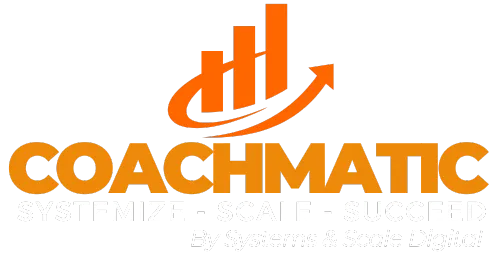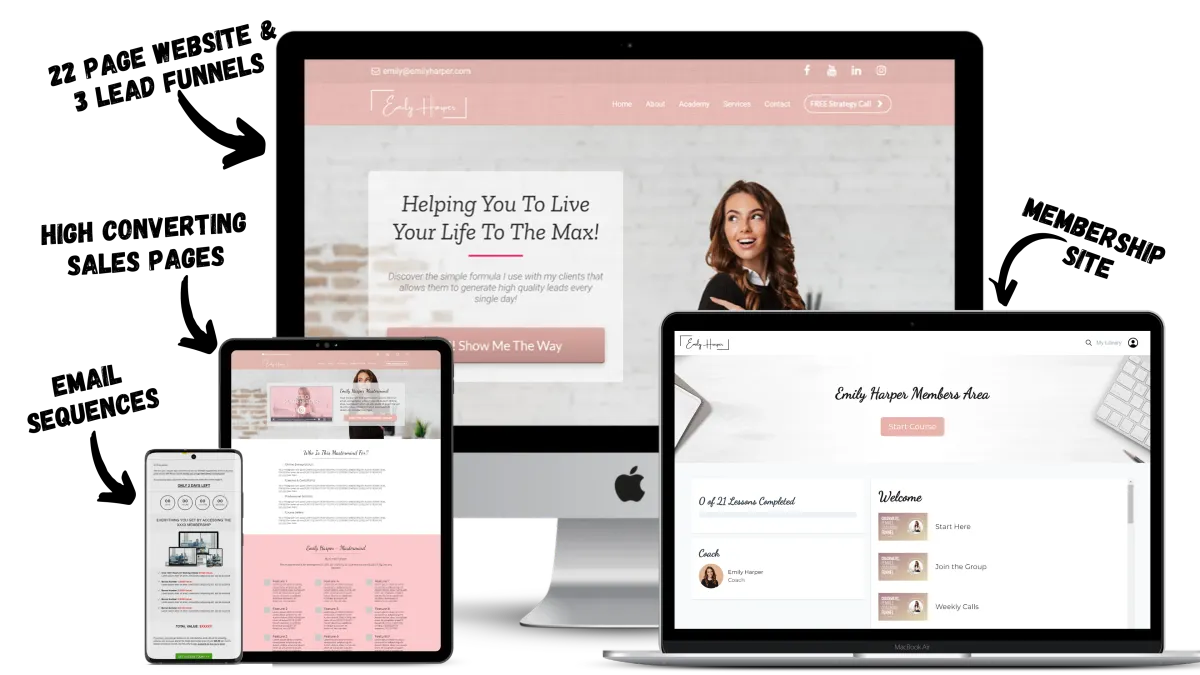
The Ultimate SEO Guide for New Websites: Boost Your Online Visibility with These Simple Steps
Welcome to the World of SEO!
Launching a new website is exciting, but building it is only the first step. How do you ensure your audience can find you online? This is where SEO, or otherwise known as Search Engine Optimization, comes in. SEO is the practice of optimizing your website so that it ranks higher in search engines like Google, helping more people find your site when they search for topics related to your business.
Why is SEO So Important?
Think about how often you use Google to find a product, service, or answer to a question. Now imagine if your site appeared at the top of those search results. That’s the power of SEO: it’s how potential customers find your business without you having to advertise to them directly. Here’s how effective SEO can grow and elevate your coaching business:
Increased Visibility: Ranking higher means more people can find you. SEO helps to drive organic traffic (non-paid visitors) to your website.
Credibility and Trust: Websites that rank highly in search results are often seen as more trustworthy by users.
Better User Experience: Good SEO practices (like making sure your site is fast and mobile-friendly) can create a better experience for your visitors.
The Drawbacks of Neglecting SEO
If SEO isn’t part of your strategy, it’s likely your site will stay hidden. Without optimizing your site, it may get lost in the vastness of the internet, meaning you miss out on potential customers who simply can’t find you.
So, let’s dive into this easy-to-follow SEO guide to help your new website gain the visibility it deserves!
1. Understanding Keywords: The Foundation of SEO
What Are Keywords?
'Keywords' are words or phrases that people type into Google or other search engines to find information. Choosing the right keywords for your website helps you connect with people who are looking for the products or services you offer.
Choosing the Right Keywords
When choosing keywords, it’s important to think exactly like your customer. If you sell organic skincare, for instance, you’ll want keywords that reflect what someone looking for your products might search, such as “organic face moisturizer” or “natural skincare for sensitive skin.”
Use Keyword Research Tools: Tools like Google Keyword Planner, SEMrush, or Ahrefs show you popular keywords and give specifics on how many people search for them each month.
Focus on Long-Tail Keywords: These are more specific phrases, like “sustainable coffee mugs,” that are often less competitive than general keywords (like “coffee mugs”). Long-tail keywords help you attract visitors with specific needs or interests, making them more likely to become customers.
Where to Use Keywords
Once you have your keywords, here’s where to place them:
Page Titles and Meta Descriptions: Think of these as your storefront signs; they tell Google (and your audience) what your page is about.
Example: If you run a baking blog, your title could be “Gluten-Free Chocolate Cake Recipe | Healthy Baking Tips.”
Headings (H1, H2, etc.): These break up your content into sections and signal important topics.
Example: Use headings like “Benefits of Gluten-Free Baking” or “Step-by-Step Chocolate Cake Recipe” on a page about gluten-free baking.
Image Alt Text: This is a short description of an image that helps search engines understand what it’s about.
Example: Use “chocolate cake with raspberries” instead of a generic description like “image1.jpg.”
URL Slugs: This is the part of the URL that comes after “.com/,” which can also include keywords for clarity.
2. Crafting Titles and Meta Descriptions That Attract Clicks
Page Titles
Your page title is the headline that appears in search results. Each page on your site should have a unique title that describes what’s on the page and includes a keyword.
Keep It Brief: Aim for 50-60 characters so that it’s not cut off in search results.
Make It Relevant: Include the main keyword you’re targeting for that page.
Example: If your page is about handmade soap, a title could be: “Handmade Soap | Natural & Organic Soaps | [Your Brand].”
Meta Descriptions
Meta descriptions are short summaries that appear under the title in search results. They don’t directly impact rankings, but a compelling meta description can encourage people to click through.
Use 150-160 Characters: Keep it concise and to the point.
Include a Call-to-Action: This could be something like “Learn more,” “Shop now,” or “Discover our products.”
Example: “Explore our handmade, organic soaps that are gentle on skin. Shop now for natural skincare!”
3. Using Headings to Organize Your Content
Why Headings Matter
Headings (like H1, H2, H3) act like a table of contents, making it easier for readers to follow and search engines to understand your page.
Use One H1 Tag: This is usually the main title of the page, like the headline of an article.
Use H2s and H3s to Organize Sections: Think of these like subheadings in a magazine article. Each new section should have its own heading.
Include Keywords Naturally: Use keywords where they fit, but don’t force them. Headings should help your audience, not just rank for search engines.
Example: On a page about sustainable skincare, use headings like “What Makes Skincare Sustainable?” and “Top Ingredients for Eco-Friendly Beauty.”
4. Optimizing URLs for Clarity and SEO
Your URL (web address) should be simple and give a hint about the content of the page.
Keep URLs Short and Simple: Short URLs are easier for users to understand and remember.
Use Keywords and Hyphens: Use words that reflect the content and separate them with hyphens, like “/handmade-organic-soap.” Avoid random characters or numbers in URLs (e.g., “/pageid=12345”).
5. Creating Quality Content that Satisfies User Intent
Focus on User Intent
User intent is all about understanding what your visitors want when they land on your page. If someone is searching “best organic soap for dry skin,” they’re likely looking for recommendations or a product, not just general information on soap.
Create Useful, Informative Content: Make sure your content directly answers common questions, solves problems, or provides valuable information.
Be Thorough: In-depth articles that are 800+ words often perform well, but aim for quality. Cover related ideas to help your readers fully understand the topic.
Natural Keyword Use
Use keywords naturally throughout your content. Search engines understand synonyms and related terms, so avoid overloading your content with the exact keyword.
6. Image Optimization for Speed and Accessibility
Why Images Matter for SEO
Images make your content more engaging, but they also impact load time. Optimized images improve both user experience and SEO.
Rename Files Before Uploading: Instead of a random file name like “IMG_001.jpg,” use a descriptive name that includes a keyword, like “handmade-organic-soap.jpg.”
Use Alt Text: Alt text is a brief description of the image that helps search engines and visually impaired users understand what it shows. Example: “Handmade organic soap bar with lavender essential oil.”
Compress Images: Large images can slow down your site. Use tools like TinyPNG or ImageOptim to make images smaller without losing quality.
7. Internal and External Linking for Better Navigation and Authority
Internal Links
Internal links are links to other pages on your website. These help users navigate and allow search engines to understand the relationship between different pages on your site.
Example: If you mention “organic skincare,” you can link to your blog post or product page on organic skincare tips.
External Links
Linking to reputable, high-quality websites adds value for readers and builds credibility.
Example: If you’re talking about the benefits of lavender in skincare, you could link to a study or reputable health site.
Use Descriptive Anchor Text
Anchor text is the clickable text for links. Instead of “click here,” use something descriptive like “learn more about organic skincare.”
8. Setting Up Google Analytics and Google Search Console
These tools are free and offer invaluable insights into how your site is performing.
Google Analytics: Tracks visitor data, like where they came from, how long they stayed, and which pages are most popular.
Google Search Console: Helps you monitor how often your site appears in search results, detect any technical issues, and see which keywords are driving traffic.
Submit Your Sitemap
A sitemap is like a roadmap for search engines. You can submit it to Google through Search Console to help Google index your site’s pages faster.
9. Optimizing Your Site for Mobile Devices
Responsive Design
More than half of all web traffic now comes from mobile devices. Make sure your website looks good and functions well on all screen sizes.
Fast Load Times: Mobile users expect sites to load quickly. Use tools like Google PageSpeed Insights to test your site’s speed and identify areas for improvement.
Tips for Faster Loading: Compress images, use caching, and reduce large files.
10. Local SEO Tips for Businesses with Physical Locations
Google My Business
If you have a physical location, setting up a Google My Business profile helps you appear in local search results and Google Maps.
Consistent Information: Make sure your business name, address, and phone number are the same across your website, Google My Business, and any other directories.
Location-Based Keywords: Use keywords that include your city or neighborhood, like “organic skincare in Austin.”
Common SEO Mistakes to Avoid
Keyword Stuffing: Overusing keywords can make your content look spam-like and can sabotage your rankings.
Duplicate Content: Avoid repeating the same content on multiple pages, as search engines may see this as an attempt to manipulate rankings.
Ignoring Metadata: Titles, descriptions, and alt text are quick wins for SEO; skipping them is a missed opportunity.
Ongoing SEO Efforts
SEO takes time, so it’s an ongoing effort. Keep monitoring your site’s performance and adjusting your strategy as needed.
Update Content Regularly: Refresh old content to keep it relevant, and create new content regularly to attract new visitors.
Monitor and Adjust: Use Google Analytics and Search Console to see which pages and keywords are working best, and refine your content accordingly.
Final Thoughts
SEO may seem technical, but by following these steps, you’ll help your new website gain visibility and attract the right audience. Remember, SEO is a long-term investment—be patient, consistent, and ready to adjust your strategy as you learn more. With time and effort, your site can become a valuable resource for your audience and a powerful tool for your business.
Ready to Make Your Coaching Website Stand Out?
If you’re a coach looking to launch or grow your business online, CoachMatic can be your one-stop solution. CoachMatic offers an intuitive platform specifically designed for coaches, with built-in SEO features that simplify optimization so you can focus on connecting with clients.
Take Advantage of Our Free 22-Page Coaching Website Template
Launch your website quickly and professionally with CoachMatic’s free 22-page coaching website template. This ready-to-use template comes fully optimized, enabling you to fast-track your online presence and engage clients right from the start.
Whether you’re new to SEO or looking for a reliable platform to scale your coaching practice, CoachMatic provides all the tools you need—from keyword guidance to mobile optimization, plus seamless integrations with Google Analytics and Search Console.
Get started today with CoachMatic, and watch your coaching business grow


